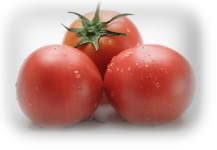
Botanically, tomato belongs to Solanaceae or nightshade family of common vegetables, which also includes chili peppers, potato, eggplant, etc. Its scientific name is Lycopersicon esculentum.
Many hundreds of cultivar varieties with different type and size, either organic, hybrid or genetically modified are being in use. Most cultivars produce red fruits; however, some cultivars with yellow, orange, pink, purple, green, or white colors are also a common scene.
Heirloom tomatoes tend to produce more natural and flavorful fruits. Heirloom cultivars are becoming increasingly popular, particularly among organic vegetable consumers. They are now grown worldwide at a larger scale as one of frontline vegetable, in line with onions, chili, potato etc.
Cherry tomatoes (Solanum lycopersicum var. cerasiforme) are small, round, cherry-sized fruits of the same Solanaceae family. They are quite popular in the Mediterranean regions featuring commonly in Italian and Greek cuisine.
Tomatoes are one of the low-calorie vegetables; hold just 18 calories per 100 g. They are also very low in fat contents and have zero cholesterol levels. Nonetheless, they are excellent sources of antioxidants, dietary fiber, minerals, and vitamins. Because of their all-round qualities, dieticians and nutritionists alike often recommend them in cholesterol controlling and weight reduction diet programs.
The antioxidants present in tomatoes are scientifically found to be protective against cancers, including colon, prostate, breast, endometrial, lung, and pancreatic tumors. Total -ORAC (Oxygen Radical Absorbance Capacity) in this vegetable is 367 µmol TE/100 g.
Lycopene, a flavonoid antioxidant, is a unique phytochemical compound found in the tomatoes. Red variety fruits tend to possess more of this antioxidant. Together with carotenoids, lycopene may help protect cells and other structures in the human body from harmful oxygen-free radicals. Studies show that lycopene protects the skin from ultra-violet (UV) rays and thus offers some defense against skin cancer.
Zea-xanthin is another flavonoid compound present abundantly in this vegetable. Zeaxanthin helps protect eyes from “age-related macular related macular disease” (ARMD) in the older adults by filtering harmful ultra-violet rays.
It contains very good levels of vitamin-A, and flavonoid antioxidants such as a and ß-carotenes, xanthins and lutein. Altogether, these pigment compounds are found to have antioxidant properties and take part in night-vision, maintenance of healthy mucosa and skin, and bones. Consumption of natural vegetables and fruits rich in flavonoids is known to help protect from lung and oral cavity cancers.
Additionally, they are also a good source of antioxidant vitamin-C (provide 21% of recommended daily levels per 100 g); consumption of foods rich in vitamin-C helps the body develop resistance against infectious agents and scavenge harmful free radicals.
Fresh tomato is very rich in potassium. 100 g contain 237 mg of potassium and just 5 mg of sodium. Potassium is an important component of cell and body fluids that helps controlling heart rate and blood pressure caused by sodium.
Further, they carry average levels of vital B-complex vitamins such as folates, thiamin, niacin, riboflavin as well some essential minerals like iron, calcium, manganese, and other trace elements.
Selection and storage
Fresh ripe tomatoes feature beautiful bright-red color and have a rich fruity flavor. In the markets, buy fresh, firm, uniform sized fruits. Avoid those with wrinkled surface, discolored spots, cuts and too soft and mushy.
Firm, yellow fruits can be placed in cool, dark place at room temperature for 2-3 days. However, ripe tomatoes are one of the easily perishable vegetables and should be stored in the refrigerator. Use them while they are fresh to gain full benefits of vitamins and antioxidants.
Preparation and serving methods
Pests are common in tomato. Hybrid varieties usually subjected to insecticide sprays. Therefore, wash them thoroughly in the cold running water in order to remove dirt, soil and any insecticide/fungicide residues.
To prepare, discard stem and top calyx end. Cut into desired halves, cubes, slices, etc. Peel the skin and puree its juicy pulp. Some prefer to discard seeds before adding in cooking.
【Reference】http://www.nutrition-and-you.com/tomato.html






